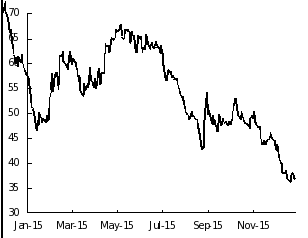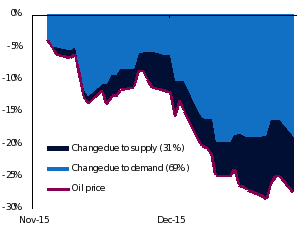Oil prices had an eventful year in 2015. They began the year by recovering some of the losses incurred in the second half of 2014, rising from USD49 per barrel (/b) in mid-January to USD68/b in early May. Subsequently, the recovery fully evaporated with oil prices falling to USD43/b by the end of August. A period of stabilisation ensued in the following two months as oil traded in the USD45-55 range. Since early November, however, oil prices resumed their decline and they are currently trading around mid-30s. The latest price decline can be attributed to a mixture of demand and supply factors.And while some analysts have highlighted the role of speculators in the recent pricedrop, we see little evidence supporting this claim.
Brent crude oil price in 2015
(USD per barrel)

Oil prices fell by 26.2% from USD51/b in early November to US37.3/b on 31 December. Demand factors are the main reason behind the fall as they were responsible for 69% of the decline. Annual growth in oil demand is estimated to have slowed sharply to 1.3m barrels per day (b/d) in Q4 2015, down from 2.2m b/d in Q3. In addition, the International Energy Agency revised down its estimate for global demand in Q4 2015 by 200k b/d. Almostall of this revision is due to North and South America, where Canada and the US seem to beexperiencing record-breaking warm weather for this time of the year. This has reduced their demand for heating energy, leading to the decline in oil prices.
While demand forces were the dominant driver of the recent decline in oil prices, supply factors also played a role as they were responsible for 31% of the fall. This was partly due to OPEC’s decision to maintain its production at current levels in its meeting on 4 December, which led to a 1.9% decline in prices on the day. In addition,potentially earlier-than-expected lifting of sanctions on Iran also contributed to the decline.
Cumulative change in oil prices from 3 November 2015 to 31 December 2015
(%; % Contribution in parentheses)

Sources: Bloomberg and QNB Economics
The role of speculation was highlighted by some analysts as a factor behind the recent decline in oil prices. These analysts point out that bets made by hedge funds on a further decline in oil prices are at a near record high. However, we see little evidence supporting this claim for two reasons.
First, hedge funds make bets on financial paper (like futures contracts and options) and rarely, if ever, take physical delivery of the commodity. Therefore, they do not impact the real demand of oil and, as a result, do not impact its price.
Second, while hedge funds positions are correlated with oil prices, movements in oil prices tend to precede changes in hedge funds positions, not the other way round. This suggests that speculative positions do not drive oil prices but instead are driven by prices. This means that hedge funds follow a “momentum” strategy in which a decline in prices lead them to bet on further declines in the future.
In conclusion, it appears that a mixture of demand and supply factors rather thanspeculation were behind the latest episode of oil price decline. Ruling out speculative forces in influencing oil prices does not mean that the market is anyless complex. Multiple factorscould drive supply and demand and some, such as weather or geopolitics, are rather hard to predict. Oil markets had a memorable year in 2015 and they enter 2016 full of questions and uncertainty.
